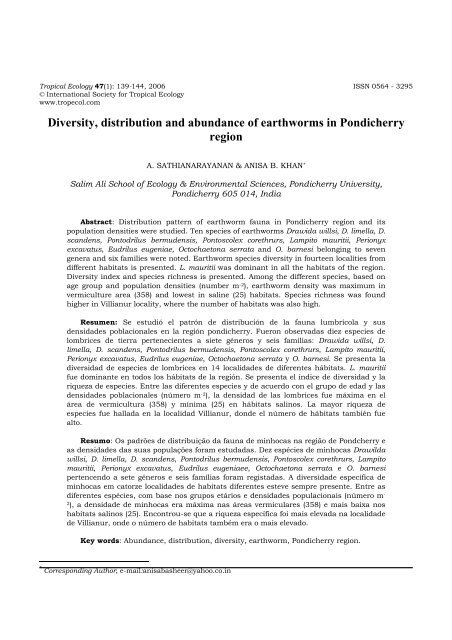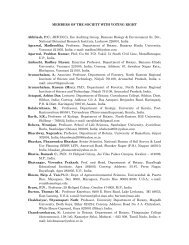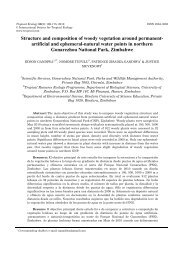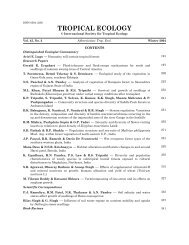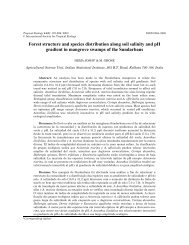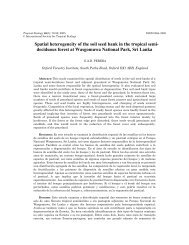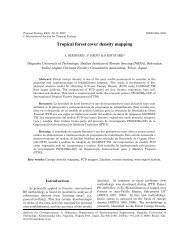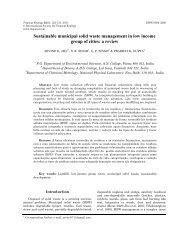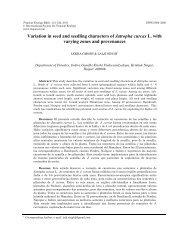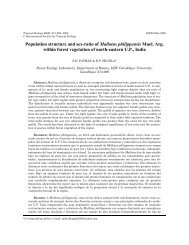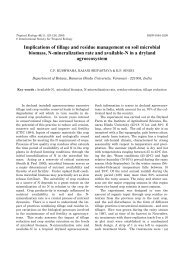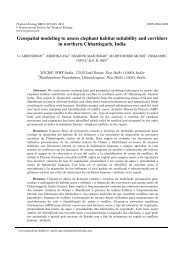Diversity, distribution and abundance of earthworms in Pondicherry ...
Diversity, distribution and abundance of earthworms in Pondicherry ...
Diversity, distribution and abundance of earthworms in Pondicherry ...
Create successful ePaper yourself
Turn your PDF publications into a flip-book with our unique Google optimized e-Paper software.
140 DIVERSITY OF PONDICHERRY EARTHWORMSIntroductionEarthworms, the soil macro<strong>in</strong>vertebrates,are prom<strong>in</strong>ent among soil fauna <strong>and</strong> regulatethe soil processes (Ismail 1997). They are found<strong>in</strong> all types <strong>of</strong> soils with sufficient moisture <strong>and</strong>food (Ghosh 1993). They act as decomposers<strong>and</strong> also a rich prote<strong>in</strong> source (Neuhauser et al.1979). Belong<strong>in</strong>g to class Oligochaeta,<strong>earthworms</strong> form the major terrestrial <strong>and</strong> soil<strong>in</strong>habit<strong>in</strong>g organisms <strong>of</strong> Phylum Annelida(Ghosh 1993). In India, Julka (1993) reported509 species <strong>and</strong> 67 genera <strong>of</strong> <strong>earthworms</strong>.Review <strong>of</strong> literature reveals that earthwormpopulation dynamics <strong>in</strong> relation to different soiltypes is known (Dash & Patra 1977; Fragoso etal. 1999). Ghosh (1993) presented the ecologicalaspects <strong>of</strong> Indian <strong>earthworms</strong> along with theirvermicompost<strong>in</strong>g technique. However, there isno report on <strong>distribution</strong> <strong>and</strong> <strong>abundance</strong> <strong>of</strong><strong>earthworms</strong> <strong>in</strong> <strong>Pondicherry</strong> region. To fill <strong>in</strong> thislacuna, the present study was undertaken. Thestudy focuses on population density, specieswise age <strong>and</strong> depth <strong>distribution</strong> <strong>in</strong> differenthabitats <strong>of</strong> different localities.Materials <strong>and</strong> methodsThe identified earthworm sampl<strong>in</strong>g sites <strong>in</strong><strong>Pondicherry</strong> region are depicted (Fig.1).<strong>Pondicherry</strong> lies at 12°N latitude <strong>and</strong> 79°Elongitude on the east coast <strong>of</strong> India. The survey<strong>and</strong> collection was done for two years start<strong>in</strong>gfrom October 2000 to September 2002.Collections were made twice a month <strong>in</strong> thefollow<strong>in</strong>g habitats: (i) paddy field, (ii) coconutfield, (iii) sal<strong>in</strong>e soil area, (iv) municipalsolidwaste (MSW) dumped area, (v) groundnutfield, (vi) poultry waste dumped area, (vii)vermicultur<strong>in</strong>g area, (viii) cowdung dumpedarea, (ix) near fresh water bodies, (x) sewagewater canals <strong>and</strong> (xi) <strong>in</strong>dustrial area. Collection,preservation <strong>and</strong> count<strong>in</strong>g <strong>of</strong> the <strong>earthworms</strong>pecies was based on age structure: [(a)juveniles, (b) non-clitellates <strong>and</strong> (c) clitellates],depth: [(a) epigeic (1 cm to 5 cm depth), (b)aneceic (10 cm to 30 cm depth), (c) endogeic (30cm to 50 cm depth)] <strong>and</strong> habitat follow<strong>in</strong>gGhosh (1993), Ismail (1997) <strong>and</strong> Jimenez et al.(2000). Species richness <strong>and</strong> diversity <strong>of</strong> speciesFig. 1. Map show<strong>in</strong>g collection sites <strong>of</strong> <strong>earthworms</strong>pecies.(d 1 ) was calculated based on Shannon-WienerIndex (Zar 1999).Results <strong>and</strong> discussionA total <strong>of</strong> ten species (seven genera under fivefamilies) <strong>of</strong> <strong>earthworms</strong> collected from<strong>Pondicherry</strong> region are presented <strong>in</strong> Table 1.Habitat wise <strong>distribution</strong> <strong>of</strong> different species <strong>of</strong><strong>earthworms</strong> <strong>in</strong> <strong>Pondicherry</strong> region is presented<strong>in</strong> Table 2. Among the identified species, L.mauritii was the only species common across allthe localities <strong>and</strong> habitats, except <strong>in</strong>Ariyankuppam sal<strong>in</strong>e habitat. P. bermudensis,reported to be frequent <strong>in</strong> estuar<strong>in</strong>e waters(Ismail 1997) <strong>and</strong> P. corethrurs mostly observed<strong>in</strong> soils with low sal<strong>in</strong>ity <strong>and</strong> high organic matter(Kale 1998) were recorded <strong>in</strong> Ariyankuppamsal<strong>in</strong>e habitat. D. willsi occurs <strong>in</strong> all localities<strong>and</strong> mostly prefers paddy fields except <strong>in</strong>Ariyankuppam. D. sc<strong>and</strong>ens /D.limella occur <strong>in</strong>paddy fields <strong>of</strong> Bahour, Abishaegapakkam,Villianur, Madagadipet, Kariyamanikkam,Karayanputhur <strong>and</strong> Kirumampakkam. However,D. limella was also recorded near fresh waterhabitats. Characteristically none <strong>of</strong> the species <strong>of</strong>Drawida was found <strong>in</strong> coconut field. Thehardness <strong>of</strong> the soil <strong>of</strong> the coconut field <strong>in</strong>
142 DIVERSITY OF PONDICHERRY EARTHWORMScarbon <strong>and</strong> nitrogen. A significant decl<strong>in</strong>e <strong>in</strong><strong>abundance</strong> <strong>and</strong> biomass <strong>of</strong> <strong>earthworms</strong> <strong>in</strong>summer can be attributed to changes <strong>in</strong> soiltemperature <strong>and</strong> moisture (Whalen et al.1998). Kale (1998) reported that <strong>abundance</strong><strong>and</strong> diversity <strong>of</strong> earthworm species is affectedby carbon <strong>and</strong> nitrogen content <strong>of</strong> the soil.
144 DIVERSITY OF PONDICHERRY EARTHWORMS(114), D. sc<strong>and</strong>ens (84), <strong>and</strong> L. mauritii (2179).Analysis <strong>of</strong> variance with respect to differentparameters was calculated (Table 5). Thepopulation density <strong>of</strong> earthworm is significantlydifferent (p
SATHIANARAYANAN & KHAN 145<strong>of</strong> Bangladesh. pp. 23-35. In: A.B. Khan (ed.)Proceed<strong>in</strong>gs <strong>of</strong> National Symposium-Environmental Crisis <strong>and</strong> Security <strong>in</strong> the NewMillennium. Anmol Publications Pvt. Ltd., India.Syers, J.K. & J.A. Spr<strong>in</strong>gett. 1983. Earthwormecology <strong>in</strong> grassl<strong>and</strong> soils. pp. 67-81. In: J.E.Satchell (ed.) Earthworm Ecology. Chapman <strong>and</strong>Hall, London.Whalen, J.K., R.W. Parmelee & C.A. Edwards. 1998.Population dynamics <strong>of</strong> earthworm communities<strong>in</strong> corn agroecosystems receiv<strong>in</strong>g organic or<strong>in</strong>organic fertilizer amendments. Biology <strong>and</strong>Fertility <strong>of</strong> Soils 27: 400-407.Zar, J.H. 1999. Biostatiscal Analysis. 4th edn.Prentice Hall International, U.S.A.


